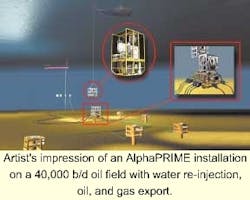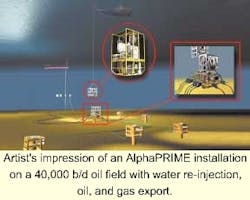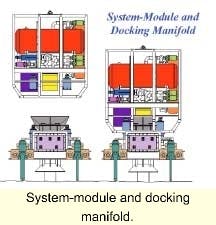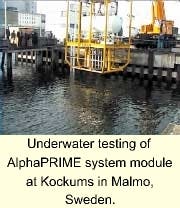SUBSEA PRODUCTION: All electric modular solution to seabed processing and field control
The AlphaPRIME diverless, all-electric, System-Modular concept was developed in order to provide the most economic and reliable means of deploying, operating, and retrieving seabed processing systems. Alpha Thames' experience dates from the 1970s when Alan Webb, one of the company's founders, worked on BP's Zakum Field offshore Abu Dhabi on which an electrically powered seabed proc-essing system was installed and operated. This was followed by GA-SP, a modular seabed proc-essing system that was engineered and success-fully tested underwater by Alpha Thames, and this in turn led to the AlphaPRIME Project.
Certain key items of subsea equipment, that were necessary for AlphaPRIME, were not available from the industry at the time. Alpha Thames has therefore developed ELEx (a high voltage, high power underwater-mateable connector), as well as a range of underwater electric actuators, REAct, PROAct and FLOAct.
Today AlphaPRIME is fully ready for field application. Furthermore, this paper will show that AlphaPRIME is an ideal vehicle for the development and control of 'smart assets'.
Need for modular system
Seabed processing systems need to:
- Optimize production and minimize cost
- Be reliable and minimize risk
- Provide flow assurance at all times
- Ensure ease of installation
- Be commissioned rapidly
- Be reconfigured and maintained easily during field life
- Be capable of step-by-step expansion of the field.
These needs are readily met by Alpha Thames' System-Modular approach, which also facilitates an efficient manufacturing route by which early production can be realized. This is achieved as the base structure, the docking-manifold, and the system-modules can be manufactured in parallel, not necessarily in the same location or country.
The base structure and docking-manifold can be installed early, and the pipelines/flowlines tie-in operations undertaken while the system-modules, which contain the long lead items, are being completed and fully system integration tested in the factory. Once completed, the system-modules can be readily and quickly installed, as fluid and electrical connections are minimized.
Continuous availability
AlphaPRIME provides 100% redundancy with continuous availability. Each installation consists of twin operating system-modules; if one is removed for any reason, the other maintains production. The deployment of a replacement system-module quickly restores the 100% redundancy. This is in contrast to certain other systems that offer built-in redundancy.
In those systems, once the duplicate components are brought into service, the remaining redundancy has diminished. Moreover, the System-Modular approach avoids the numerous wet-mateable interfaces and additional isolating components that are necessary in insert retrievable systems and which thereby diminish reliability significantly.
If field characteristics dictate, the system-modules can accommodate separation systems. This will enhance the production rate and lengthen viable field life and also provide flow assurance by avoiding, for example, the problems of slugging and hydrate formation.
Each identical system-module has a footprint of 5 meters by 4 meters and is 6 meters high. It weighs 25-50 tons in air, depending upon the equipment required within it, and can therefore be deployed by relatively light support vessels equipped with a suitable crane or A-frame. ROV assistance is required but all installation, maintenance and retrieval operations are diverless. The only wet-mateable connections for each system-module are the wellhead-type connector for fluid and mechanical connections, and the electric power and control connectors.
Each system-module accommodates a processing system that is complete with electrical power distribution and control systems. With hard wired, fully factory tested connections and minimum use of wet-mateable interfaces, the entire system undergoes total system integration testing and also "burning-in" of the components for increased reliability. As a result of this approach to the design and testing, commissioning on the seabed entails little more than a leak and function test.
The installation (or change out) and commissioning of a system-module can be achieved speedily, allowing the advantage to be taken of a short weather window. The ease with which the system-modules can be changed out provides the opportunity to reconfigure the processing system at any time during field life.
For example, a system that only requires manifolding at the start of field life can be reconfigured to a separation system, when required, in later years. This means that capital expenditures occur only if and when needed, instead of being concentrated at the start of field life. Furthermore, the equipment need only be specified to suit its reduced operational life in a given system-module configuration. The equipment in both twin system-modules is operated simultaneously from the outset and therefore start-up problems, when bringing online dormant equipment, are eliminated. In the same way, new technology can be introduced into the system as it becomes available to the industry.
Future expansion
The AlphaPRIME system can readily accept future expansion of the field, or tie-in of an additional field. Obviously, the capacity of the system will need to match that of the total production throughput anticipated. AlphaPRIME can be sized and configured to best advantage if potential future expansion is allowed for at the design stage.
Decommissioning is another important consideration. AlphaPRIME system-modules slot into a docking manifold that, in turn, is accommodated within a base structure. The latter normally employs a foundation system such as a monopile or mudskirt gravity base, depending on the seabed conditions. The system-modules and the docking-manifold can be readily retrieved to the surface for refurbishment, reconfiguration and re-use elsewhere. In the case of a monopile foundation system, the base structure can also be readily retrieved. However, other foundation systems, would be recovered by conventional means.
Parameters for project
The overall aim of the project was to optimize AlphaPRIME for maximum revenue and reliability, minimum capital cost and operating cost. The latter would be achieved through the well-documented advantages of installing processing systems on the seabed as well as through savings in maintenance costs that are to be made by using diverless, all-electric system-modules. Another aim was to ensure that the system would be versatile enough to include new technology in addition to established processing technology.
AlphaPRIME embodied the integrated System-Modular approach from the outset. The initial design concept (then known as MUST) gained DNV approval in 1991 (and complies with DNV RP 0401 and API RP 17A). Intermediate designs followed and Lloyds Register's approval in principle was gained in 1998. The prototype system-module was successfully tested under the auspices of the EC-funded 'SOP Project in 1999 and these in-factory and underwater tests were witnessed and approved by DNV.
Alpha Thames and its parent company Kockums Engineering undertook the testing and demonstration of a prototype system-module and associated equipment such as underwater, electric actuators. The prototype system-module was electrically powered and controlled, and was equipped with a horizontal, two-phase separator, a single-speed pump and REAct and PROAct electric actuators. The interfaces with the docking-manifold were the MATE valved, multi-ported fluid connector, the ELEx 11kV connector and the control system connector. The test system included a simulation of a subsea well that fed a 20,000 boe/d input flowrate to the system-module.
The prototype system-module was built and tested in Kockums' factory in Malm", Sweden and was also tested underwater in the adjacent harbor.
As there were environmental restrictions on the use of hydrocarbons, water and air were commingled in the test system. The system-module successfully separated these two fluids and the outputs were monitored to ensure complete separation. Demonstrations of the diverless deployment and underwater tests were subsequently given to representatives of the offshore industry. The short time taken to commission the system-module, immediately following installation, was favorably received.
Power in deepwater
AlphaPRIME is essentially an all-electric system that is powered by a high voltage supply from the host facility. The absence of hydraulics and use of all-electric power and control combine to minimize the number of interfaces and optimize reliability. This is an important consideration in deepwater applications.
Power is fed to each system-module by means of a power/control umbilical cable that may also incorporate chemical injection lines. The system-modules can also be connected to each other to form a "ring main." This has the advantage that any one system-module can be isolated by means of switchgear in the adjacent system-module and/or that at the host facility. Therefore, it is possible to isolate and retrieve a system-module while maintaining power to the remaining modules, even if its switchgear is faulty. Each system-module has a main transformer within a pressure-balanced housing and a power and control pod. The latter is a pressure vessel with two compartments, one for power equipment (secondary transformers and switchgear) and one for control equipment.
All equipment within the pod operates in a dry, notionally one-atmosphere environment. This enables well-proven, industry-standard, highly reliable, solid state, electronic control systems to be applied. The programmable logic controller (PLC) which is located in the power and control pod controls the process and responds to signals from the subsea sensors. Commands are sent from the master control station (MCS) on the host platform or shore-based facility and process values are sent to the MCS.
Since most process values vary fairly slowly, the requirements for data transmission are moderate. By this means, the seabed system continuously monitors and controls itself, sending data to a topside master control unit but only needing to alert topside staff of unusual events, whereupon manual control can be assumed. As the system is software-controlled, software changes can be made at the MCS via the communication link often without interrupting the production process. Since the system-modules function as autonomous systems, they can be programmed to continue to operate (for a pre-determined time) in the absence of control signals from topsides, after which they will automatically shut down in a controlled manner.
Pressure and temperature sensors are located inside the power and control pod. Level switches are also fitted to verify that there has been no water intrusion. There are also sensors that monitor voltages, currents, electrical insulation and contactor positions to ensure that information on the electrical and electronic system conditions are provided at the MCS.
Control center
An AlphaPRIME installation can distribute power to neighboring seabed systems. It can also act as a control center that provides feedback data as it operates autonomously, yet offers the operational flexibility of being re-programable from the host facility. Moreover, AlphaPRIME can incorporate reservoir surveillance. If required, AlphaPRIME can be configured to include hydraulic power units (HPU) in order to control conventional electrohydraulic trees.
In the seabed processing system, the valves are operated by the electric actuators that have been specially developed by Alpha Thames. It should be noted that existing proprietary subsea valves are used and that the electric actuators do not come into contact with the hydrocarbons.
If the configuration of a system-module includes a separation process, the fluid levels in the separator are monitored and are adjusted as necessary by the use of modulating valves in the system. These valves are operated by PROAct electric actuators - this enables single speed pumping to be used to boost the liquid outputs.
The pumps can therefore be selected to operate at their optimum speed for maximum reliability and efficiency. Moreover, the need for complex and bulky speed control systems is obviated. As a proportion of pump output may be recirculated back to the separator, any heat generated is imparted to the separator thus assisting in the processing of the fluids. An electrically powered system can, if necessary, be configured to provide additional heat to the process system and to the pipelines.
Where the modules are equipped with choke valves, they are operated by FLOAct electric actuators. The separator is protected by an isolation valve that is operated by REAct, a fail-safe electric actuator which, in the unlikely event of a power failure (or if an emergency control on the panel on the host platform is operated), will immediately close the valve.
Future of subsea systems
System-Modular installations can accommodate a great variety of hydrocarbon processing systems and power and control equipment. They can be readily reconfigured during field life to cater for reservoir, infrastructure and technology changes such as the introduction of subsea compressors. This would increase drawdown and maximize early production - it would also increase the flowing pressure of the gas from the seabed processing system and would allow the use of a smaller diameter pipeline back to the host facility and also even longer tiebacks.
Another example is the monitoring of the oil content of produced water - while it is possible to separate produced water, a satisfactory method of continuously monitoring its oil content has not yet been developed for subsea use. However, a number of methods are being investigated and once this goal has been achieved, separated water may be jettisoned to the sea without the need for transporting the water to the host facility.
AlphaPRIME can act as central processing units (or nodes of a field development network) for step-by-step field development, power, and control. The System-Modular installations can provide a control hub for an autonomous "smart" control system, distribution of control data, reservoir monitoring, remotely re-programmable software and data communications.
Revenue would be maximized by the incorporation of these intelligent systems which optimize production and provide total hydrocarbon recovery management. Operating costs are minimized by closer monitoring of the process system combined with greater precision in the injection of chemicals. These intelligent systems can operate with a power/control buoy and HF radio or satellite link. Field electric power distribution, electric actuators for Christmas trees and power for HPUs can also be provided.
Further development is planned. BEL Valves in the UK is testing the AB3 isolation valve and this will be incorporated in the MATE (a single datum multi-ported connector with integral ABB valves) so that manifolding valves will be within the system-modules. This will facilitate rapid well testing without any need to shutdown production and without the need for a dedicated test line. The CUSP underwater connection system for rigid flowlines is to be developed further.
In conclusion, it may be seen that AlphaPRIME diverless, all-electric, system-modular technology provides seabed hydrocarbon processing and smart field control, packaged for initial choice and subsequent flexibility. Field studies show that this technology can be configured to achieve optimum returns from specific fields with minimum expenditure and maximum reliability. It can also be applied to installations in lakes and other inland scenarios.
Reference
This is a summary of a technical paper presented at the Offshore Production Technology Conference, London, organized by SMi, February 2001.
For more information contact David Appleford, Alpha Thames Engineering: tel +44 1708 229229, fax +44 1708 251273, E-mail: [email protected]



